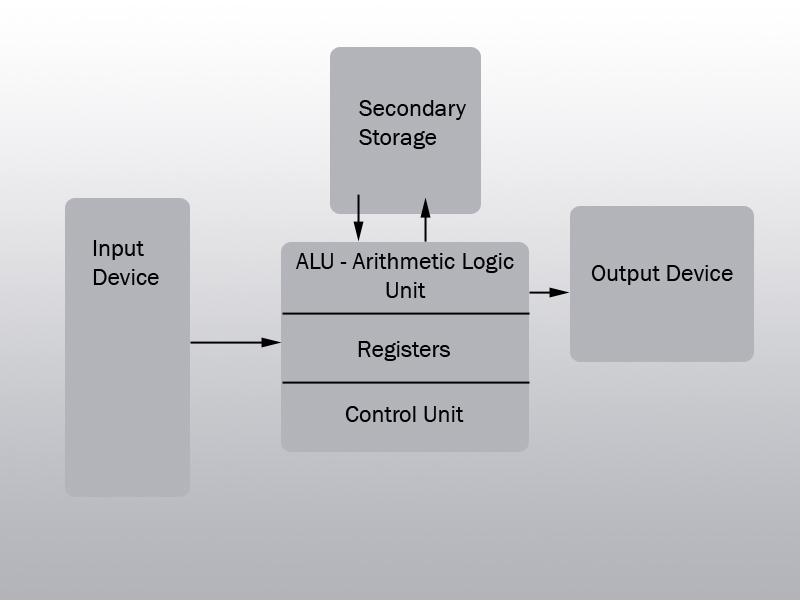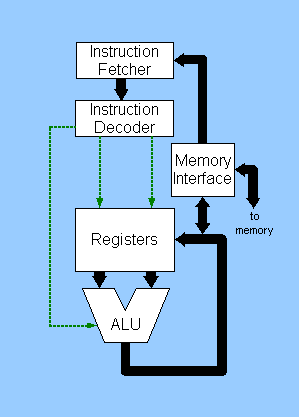Hi friends in this article let us discuss about the history, working and developments of the Central Processing unit(CPU)
Basic information
CPU which is expanded as the Central Processing Unit is nothing but a microscopic circuit and this CPU serves as the main information processor in a computer.The image below shows the CPU that we use in our houses

It is usally a single microprocessor and it is made from a wafer of the semiconducting material,which is usually silicon, and it consists of millions of electrical components on its surface.
The CPU directs the logical and arithmetical functions and also plays a vital r0le in executing the computer programs and the CPU is located on a motherboard with other chips.
The Central Processing Unit is usually regarded as the "Brain of the computer" as it is microscopic circuit or chips which serves as the main "information processor" in a computer. As every body knew currenly we use Pentium processor which was made by the Intel and very fast development is taking place in this.

Technically speaking, CPU is nothing but a number of "interconnected processing units" and each of them is responsible for any one of the aspect of the CPU’s function.
Usually any standard CPUs contain the processing units and the function performed by these processing unit includes
i)It interpret and implement software instructions
ii)Perform calculations and comparisons
iii)It makes logical decisions,i.e., based on the Boolean Algebra it determines whether the given statement is true or fals
iv)It stores the information temprorily so that it can be used by another CPU’s processing units
v)It also keep in track of the current step during the program execution
vi)It also allows the CPU to communicate with the rest of the computer
Out of several hardware components present in a PC, the smallest hardware companent which can still perform vast operation is this computer chip and a computer chip is usually made up of the semi-conductors and also the tiny wires which are laid out on top of thin wafers of silicon.

A computer chip is formed by sandwiching the layers of wire and semi-conductors between layers of silicon. The semi-conductors are configured in such a way to represent either a 0 or a 1 during the suply of electricity to them.
Usually most kinds of hardware are said to 'hard-wired', because once they are made, the configuration of the computer chips cannot be changed
History and Developments
i)In Early Computers
CPUs were generally made of vacuum tubes and also electric relays during the very early computers used and it doesn't have any microscopic transistors on computer chips as we have in today's modern computers.
So the use of vacuum tubes and electric relays in the early computers made the requirement of a great deal of power compared to today’s microprocessor-driven computers.
In 1946 the ENIAC (Electronic Numerical Integrator And Computer), which is the first general purpose electronic computer and basically this filled a large room as shown in the image below
![]()
In this type of computers more than 18,000 vacuum tubes were used for developing the CPU and also the input/output circuits.During a decade from 1946 to 1956, basically all computers used CPUs which consumed large amounts of energy and it was also in need of continual maintenance, as the vacuum tubes burned out frequently and had to be replaced.
ii)Transistors
So to solve the problems of this bulky size and large power consumption by vacuum tubes the American physicists John Bardeen, Walter Brattain, and William Shockley demonstrated an electronic switching and amplifying device, which later becomes the basic component for all electronic devices and is called as called the transistor and they founded this in 1948.The image belos shows the first transistor used

Basically this transistor had the capacity to work at a faster rate and they are also more reliably and part from this it over comes the major disadvantage of excess power consumption in vacuum tube as it consumes only very less power.
But to implement this practically on the computer 9 years were spend and the first commercially available computer to use transistors in its circuitry was the UNIVAC (UNIVersal Automatic Computer),and it was delivered to the United States Air Force in 1956.The image of UNIVAC is shown below

iii)Integrated Ciruits - Modern Revolution
The Computer chip which is considered as the very powerful device and the research on this was started 1958 and it happened when Jack Kilby of Texas Instruments demonstrated that integration of various components of a CPU onto a single piece of silicon was practically possible and these computer chips were named integrated circuits (ICs) as they combined multiple electronic circuits on a single chip.
So further design and manufacturing advances, made the transistor densities on integrated circuits so that the operation speed increases tremendously.Originally the ICs(The first ICs) consisted of only tens transistors per chip, but now it is incomparable as we use even billions of transistors per chip.

Another developmeny in the Ics was in 1967, when Fairchild Semiconductor introduced a single integrated circuit made possible of all the arithmetic logic functions for an eight-bit processor.But a fully working IC computer required additional circuits because they need to provide register storage, data flow control, and memory and input/output paths.
This requirements was made possible by the Intel Corporation and they accomplished this in 1971, when they introduced the Intel 4004 microprocessor.Even tough this 4004 was designed to manage only four-bit arithmetic,yet it was powerful enough to become the core of many useful hand calculators during that time.
The Altair 8800,which was introduced in 1975 by the Micro Instrumentation Telemetry Systems was the first personal computer kit to feature an eight-bit microprocessor.The production and marketing of computers started to increase as the microprocessors used were less cost and highly reliable
This marked the introduction of the concept personal computer.The x86 CPUs,i.e., the 8086 16-bit microprocessor was introduced by Intel in 1978.But at present the 32-bit microprocessors are very, and this development increases rapidly with 64 - bit microprocessors etc.Usually high-performance processors can run with internal clock rates that exceed 3 GHz, or 3 billion clock pulses per second.
Working of CPU
The working of the CPU can be explained in the following four sections

1)Function of the CPU
The working of CPU on a smaller basis can be compare to that of a calculator, but the CPU much more powerful that that of the calculator. The primary functons that a CPU perorms are the arithmetic and logical operations on any data, which may be taken either from the memory or the data can also be any information which is entered by the use through some input devices like a keyboard, scanner, or joystick.
A computer program is nothing but a list of software instructions which are controlled by the CPU. Usually any kind of software instructions that enters the CPU, will originate in some form of memory storage device like that of a hard disk, floppy disk, CD-ROM, or magnetic tape.
After this step these instructions are then passed into the computer’s memory called as the random access memory (RAM).In the RAM,a memory location or a uniques address is usually given to the each instruction . This unique address is specified so that the CPU can access the required data in the RAM by jusst specifying the address of the data that is required by the CPU.
Now let us consider the next step of executing the program and whn it is executed,the data flow is from the RAM through the bus,which is an interface unit of wires and it connects the CPU and the RAM. Then the data are decoded by a processing which is called as "instruction decoder".The function of the instruction decoder is that it interprets and implements software instructions.

The data from the instruction decoder is then passed to the arithmetic/logic unit (ALU).The function of the ALU is that it performs calculations and comparisons.In the ALU the data may be stored temprorily in the temporary memory locations called as the registers so that it could be retrieved quickly.
Apart from this the ALU also performs operations like addition, multiplication, and conditional tests on the data and it is usually performed in its registers,and after that it sends the resulting data back to the RAM or it is stored in another register for any future use.During this process,a unit called "Program Counter" is mainly used to keep track of each successive instruction so as to ensure that the program instructions are followed by the CPU in a correct sequence.
2)Branching instructions
Usually the program counter present in the CPU advances sequentially through the instructions, i.e one istructions after other. But this is not the case always because some special instructions like branch or jump instructions are used and these allow the CPU to abruptly shift to an instruction location out of sequence.
Normally these branch instructions may be either conditional or unconditional.When we consider a conditional, it usually tests the result of a previous operation so as to check whether the branch should be taken or not.Consider for example,a branch should be taken only if the result of a previous subtraction produces a negative result.
Usually the data which are tested for conditional branching are stored Flags, which is a special locations in the. But in the case of unconditional branch, it always jumps to a new,and this is not in order and it is generally in out of order instruction stream.
3)Clock Pulses
The measure of the speed of a processoris called as the clock pulse.Usually, the CPU is driven by one or more repetitive clock circuits and these circuits send a constant stream of pulses throughout the CPU’s circuitry.With the help of these clock pulses, the CPU synchronize its operations.Any smallest increments of CPU work are completed between the sequential clock pulses.

But in the case of any complex task several clock periods are required to be completed.Generally the clock pulses are
measured in number of pulses per second or Hertz. For example,consider a 2-gigahertz processor.This processor has 2 billion clock pulses which passes through it in one second.
4)Numbers handled by the CPU
Generally most of the CPUs handle two different kinds of numbers, and these includes
i)Fixed-point numbers and
ii)Floating-point numbers.
In the case of the fixed-point numbers,on either side of the decimal point it has a specific number of digits and this
restriction limits the range of values which are possible for these numbers, but it also ensures the faster arithmetic
operation is perormed.
Floating-point numbers usually expressed in a scientific notation,where a number is represented as a decimal number which is multiplied by a power of ten. The reason why we use scientific notation is that it is a compact way for expressing very large or very small numbers and apart from this it also allows a wide range of digits before and after the decimal point.
This is very useful and essential for representing any graphics or scientific work.But one disadvantage of this floating-point arithmetic is that it is more complex and it usually takes a longer to complete and as a result we require many CPU clock periods for performing any operations.
So this naturally makes the CPU’s floating-point computation rate lesser than its clock rate.In some case, computers use a special floating-point processor,which is called as the coprocessor,and it works in parallel to the CPU so that it can increase the speed of the calculations using floating-point numbers.In many PCs, such as Intel's chip, this coprocessor has becomes standard one.